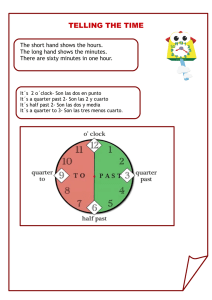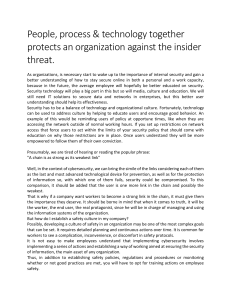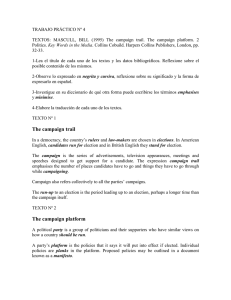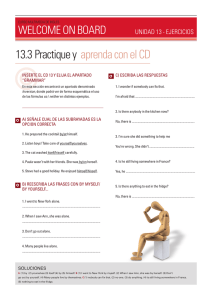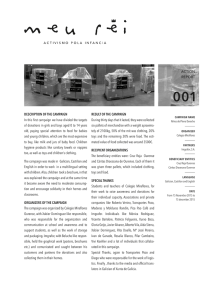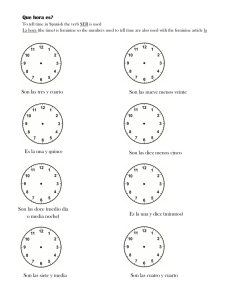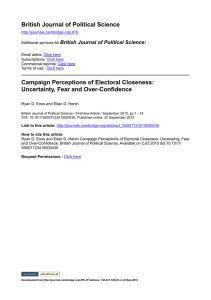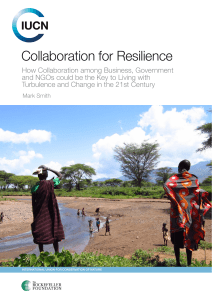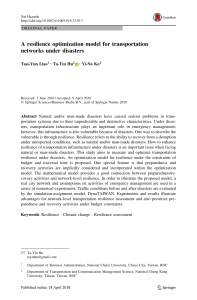Awareness-raising and education campaigns to strengthen resilience
Anuncio
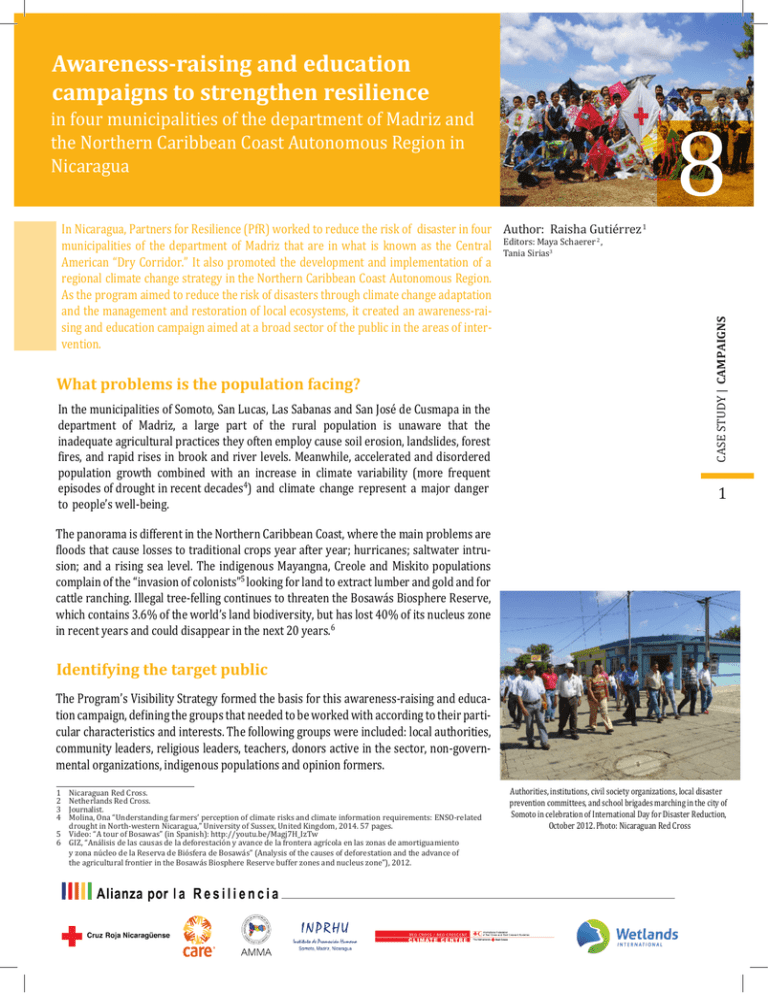
in four municipalities of the department of Madriz and the Northern Caribbean Coast Autonomous Region in Nicaragua In Nicaragua, Partners for Resilience (PfR) worked to reduce the risk of disaster in four Author: Raisha Gutiérrez 1 Editors: Maya Schaerer 2 , municipalities of the department of Madriz that are in what is known as the Central Tania Sirias3 American “Dry Corridor.” It also promoted the development and implementation of a regional climate change strategy in the Northern Caribbean Coast Autonomous Region. As the program aimed to reduce the risk of disasters through climate change adaptation and the management and restoration of local ecosystems, it created an awareness-raising and education campaign aimed at a broad sector of the public in the areas of intervention. What problems is the population facing? In the municipalities of Somoto, San Lucas, Las Sabanas and San José de Cusmapa in the department of Madriz, a large part of the rural population is unaware that the inadequate agricultural practices they often employ cause soil erosion, landslides, forest fires, and rapid rises in brook and river levels. Meanwhile, accelerated and disordered population growth combined with an increase in climate variability (more frequent episodes of drought in recent decades4) and climate change represent a major danger to people’s well-being. The panorama is different in the Northern Caribbean Coast, where the main problems are �loods that cause losses to traditional crops year after year; hurricanes; saltwater intrusion; and a rising sea level. The indigenous Mayangna, Creole and Miskito populations complain of the “invasion of colonists”5 looking for land to extract lumber and gold and for cattle ranching. Illegal tree-felling continues to threaten the Bosawás Biosphere Reserve, which contains 3.6% of the world’s land biodiversity, but has lost 40% of its nucleus zone in recent years and could disappear in the next 20 years.6 8 CASE STUDY | CAMPAIGNS Awareness-raising and education campaigns to strengthen resilience 1 Identifying the target public The Program’s Visibility Strategy formed the basis for this awareness-raising and education campaign, de�ining the groups that needed to be worked with according to their particular characteristics and interests. The following groups were included: local authorities, community leaders, religious leaders, teachers, donors active in the sector, non-governmental organizations, indigenous populations and opinion formers. 1 2 3 4 5 6 Nicaraguan Red Cross. Netherlands Red Cross. Journalist. Molina, Ona “Understanding farmers’ perception of climate risks and climate information requirements: ENSO-related drought in North-western Nicaragua,” University of Sussex, United Kingdom, 2014. 57 pages. Video: “A tour of Bosawas” (in Spanish): http://youtu.be/Magj7H_IzTw GIZ, “Análisis de las causas de la deforestación y avance de la frontera agrícola en las zonas de amortiguamiento y zona núcleo de la Reserva de Biósfera de Bosawás” (Analysis of the causes of deforestation and the advance of the agricultural frontier in the Bosawás Biosphere Reserve buffer zones and nucleus zone”), 2012. Authorities, institutions, civil society organizations, local disaster prevention committees, and school brigades marching in the city of Somoto in celebration of International Day for Disaster Reduction, October 2012. Photo: Nicaraguan Red Cross Women stand out in risk management The awareness-raising campaign was launched on International Day for Disaster Reduction in 2012.7 During the event the work carried out by women and girls to strengthen community resilience and disaster risk reduction was highlighted. CASE STUDY | CAMPAIGNS “On many occasions, women’s opinions have not been taken into account. Today, we want to be taken into account, to demand this space. One of the best experiences we’ve had as women is that we have surpassed ourselves when disasters hit and are always there to help people that need us,” said Claudia Gutiérrez, a leader from the community of Miramar, municipality of Las Sabanas, Madriz.8 2 Fancy-dress competition involving costumes made of recycled materials worn by preschool girls from San José de Cusmapa during the food fair held in April 2013. Photo: Nicaraguan Red Cross Women´s participation was also fundamental in the holding of workshops on natural medicine and alternative foods that were organized in the framework of the Harmonization of Indigenous and Local Knowledge.9 This in turn allowed the design and staging of a food fair under the slogan “Human health is a re�lection of the Earth´s health.”10 The fair was held in April 2013 in San José de Cusmapa, its main objective being to promote the recovery of native seeds and locally-produced alternative foods and their inclusion in the family diet. The fair also raised the population’s awareness of reusing solid waste by transforming it into useful products. Schools join the campaign! As part of the campaign, a series of extra-curricular activities11 was established with primary and secondary schools. In the municipality of San Lucas, for example, over 1,200 children, teachers and parents were sensitized. With support from the Ministry of Education (MINED), small school forums were promoted in preparation for the municipal environment forums organized in 2013 and 2014. The children and parents promised to ensure reforestation, the recycling of solid waste and river watershed management in the schools. A play presented at rural schools in the municipality of San Lucas. Photo: CARE 9 Case study: “Harmonization of Indigenous and Local Knowledge,” Partners for Resilience, Nicaragua, 2014. Available in Spanish at: http://www.desaprender.org/clip/nicaragua-conocimiento-indigena-pdf 11 See the play “Nature doesn’t talk, it just acts” https://www.facebook.com/carenicaragua/photos/a.694659097215417.1073741829.694622197219107/797138226967503/?type=1&theater (in Spanish); and the article “Nature just acts” (in Spanish): http://www.care.org.ni/noticias/?noticia=23 7 Video: “Education Fair: Disaster Reduction Day 2012, Somoto, Nicaragua” http://youtu.be/QKQrzR1LDbA 8 Video: “What is the role of women in community resilience?” http://youtu.be/pjDFGCEfrTM 10 Video: “Food Fair, International Mother Earth Day, April 24, 2013, Cusmapa” (in Spanish) http://youtu.be/Adv1FgKMHvw 11 “Doing murals with young people from San José de Cusmapa and Las Sabanas” (in Spanish) http://youtu.be/xkxjnoNETbc; “Wind festival: kite competition” (in Spanish) http://youtu.be/lEMv9VnqIs8 Youth networks communicate and sensitize the community The Youth Network of the Indigenous People of Cusmapa and the Young Voice Network of the Las Sabanas Youth Center, made up of students and professionals from the respective municipalities, also participated in different PfR Program activities. An ecologist teacher Thirty-two-year-old Francisco Anyel Maldonado is the director of the Rafael María Fabretto Secondary School in San José de Cusmapa. He de�ines himself as an environmental activist and regularly attends ecological walks, tourist guide workshops and anti-forest �ire brigades. He instils this passion into his students and colleagues, thus promoting an awareness-building campaign among the educational community. CASE STUDY | CAMPAIGNS Maldonado is also an active member of the Youth Network of the Indigenous People of Cusmapa and has participated in a broad awareness-building process through different actions carried out and developed with the PfR Program. “At the beginning of the Program for Disaster Risk Management in the Face of Climate Change my knowledge as a teacher was based on the academic training I received at different universities,” he recalled. “But thanks to the PfR training I’ve been able to participate in workshops, environmental walks, school fairs, competitions involving traditional games and a workshop on participatory videos.” He added that the training received on editing participatory videos has given him the chance to inform the community or the municipality about the real situation and publicize problems, because video is a management tool with respect to the authorities and external donors. “Thanks to this initiative, we learned editing programs and can now edit videos of a social and cultural nature to present to other people,” Maldonado explained. Francisco Anyel Maldonado has participated in several PfR Program workshops and applied his new knowledge with the Youth Network of the Indigenous People of Cusmapa and with his students. Photo: Nicaraguan Red Cross In addition to being a motivator behind the Youth Network of the Indigenous People of Cusmapa, Maldonado also shares his knowledge with other teachers, who value his willingness to participate in different activities of the PfR Program without neglecting his own educational work. Starting in 2013 with support from the organization Pool de Trainers12, participatory video was promoted as a social strengthening tool to improve basic skills for documenting changes in attitudes and practices and for promoting culture and decision-making. The messages produced, �ilmed and edited by young people were shown to the community, decision-makers and donors. The process started with learning to use the video equipment and an editing program. Pool de Trainers also produced a documentary on the Tapacalí River sub-watershed, providing a tool with which to continue sensitizing the population on the area they live in. Participatory video workshop with networks of young people from Las Sabanas and San José de Cusmapa. Photo: Nicaraguan Red Cross 12 Article: “Building resilient communities” (in Spanish): http://pooldetrainers.com/Info/DetalleActividad/83 3 Promoting art to guarantee a protecting environment “…Mother earth is suffering from the negative blow dealt by man. I’m living with the consequences so it’s time to act...” Resilience is based on strengthening the capacities and talents that people and communities have for conserving and managing in favor of collective wellbeing, which should include a healthy environment. Photo: Nicaraguan Red Cross CASE STUDY | CAMPAIGNS Song: I’M POSITIVE Author: Lenín Baéz. Municipality: San José de Cusmapa Winner of the 1st Environmental Music Festival, 2013 With the aim of stimulating local artistic creation and promoting good management and environmentally-friendly practices, a �irst Environmental Music Festival was organized. Hundreds of people participated and a total of six contestants took part, including groups, duos and soloists from the municipalities of Somoto, Las Sabanas and San José de Cusmapa. An ecological rally on the Tapacalí River sub-watershed 4 As part of the awareness-building actions, a Tapacalí Cycling Rally was organized in May 2014 under the slogan “The Earth loves our hands and fears our footsteps.” This activity highlighted the sub-watershed’s economic and environmental value and included the Program’s main areas. It was also an opportunity to disseminate the work done on the Tapacalí River sub-watershed, which covers an area of 156.93 km2 (15,693 hectares). 13 The event stressed the importance of environmental assets and services for disaster risk reduction and promoted the idea of establishing and protecting the area as a biological corridor between the Tepesomoto-La Patasta Nature Reserve and the Somoto Canyon National Monument. “This cycling rally is an activity that has to do with raising environmental awareness about our Tepesomoto-La Patasta Natural Reserve, the effects of climate change and disaster risk reduction in the Tapacalí River sub-watershed. The aim is to inform about the tourist attractions of Las Sabanas and I understand that the Municipal Council has approved a special agenda for today, with activities kicking off with the promotion of this mountain Photo: Nicaraguan Red Cross sport that young people like so much.” Héctor Rodezno, promoter with the Madriz Delegation of the Nicaraguan Tourism Institute (INTUR). Local young people and children actively participated in this event. Along the way they also received talks about the importance of water, the illegal traf�icking of �lora and fauna species and the ecology of birds, with the support of the SONATI-Estelí Association. 13 “Plan de Manejo y Gestión Integral Subcuenca del Río Tapacalí” [Comprehensive Tapacalí River Sub-Watershed Management Plan], Nicaraguan Red Cross (Partners for Resilience Program), Central American University, 2014. Somoto, Nicaragua. 298 pages. Video: “Environmental Music Festival, Las Sabanas” (in Spanish): http://youtu.be/zwLYfRonbbA Video: “Tapacalí Cycling Rally – May 15, 2014” (in Spanish): http://youtu.be/_mXDHUT8MSk The �ight against garbage and the use of plastic bags Reusable bags were distributed in the city of Somoto in the department of Madriz 14 and The clean-up campaign in the Quebrada Sucia micro-watershed in the municipality of San Lucas was a successful example of the awareness-raising campaign. A total of two tons of solid waste were gathered from the brook, an activity that was accompanied by the handing out of reusable bags and discouraging the use of plastic bags. The campaign involved the participation of the municipal authorities, the Federation of Secondary School Students (FES), the Guardabarranco Environmental Movement and the Municipal Network of Young Indigenous People. In 2013, in coordination with the Las Sabanas Mayor’s Of�ice and the Ministry of Health (MINSA), a clean-up campaign was conducted in the municipality’s urban area and an abate application campaign was carried out to prevent the propagation of the mosquito that transmits dengue fever. In 2014, the initiative was replicated in an urban-level “Cleanest Backyard” campaign as part of a national clean-up and awareness-raising campaign to destroy sources of propagation and breeding grounds of the mosquito vectors of dengue16 and chikungunya.17 Radio information campaign Alongside these activities, a radio awareness-raising campaign was conducted through traditional media. It involved support from the Ministry of the Environment and Natural Resources (MARENA) and the Nicaraguan Agricultural Technology Institute (INTA) for the dissemination of six radio spots on topics related to river watersheds, disaster risk reduction, drinking water and sanitation committees, and climate change. Meanwhile, the broadcasting of the “¿Sabías que…?” (Did you know that…?) program ensured the messages had coverage in over 20 municipalities. In conjunction with the United Nations Development Program (UNDP) in the Segovias region, Partners for Resilience trained local journalists on subjects related to disaster risk reduction, climate change adaptation and ecosystem management and restoration. Campaign to raise awareness of garbage management in the Northern Caribbean Coast Autonomous Region. Photo: Nicaraguan Red Cross “Today we are starting to clean up the Quebrada Sucia micro-watershed.This work we are doing in alliance and complementarity with PfR has been strengthening all of the social aspects we’re promoting. This clean-up campaign is designed to make us alert to prevent all risks of flooding due to the accumulation of garbage in the brook. We have to really emphasize the areas of greater risk, such as the border communities, and void the propagation of dengue, eliminating pools of water and garba-ge throughout the municipality. With everyone’s participation we can eradicate the centers of infection to avoid illnesses.” The mayor of San Lucas, Deysi Pérez Vázquez, at the launch of the 2014 awareness-raising campaign under the slogan “Clean micro-watersheds give us clean water.” 14 Article in the Nicaraguan daily newspaper La Prensa´s Departmental section –“Entregan bolsas ecológicas” (Ecologlical bags given out), July 27, 2012: http://noticias.laprensa.com.ni/2012/ 07/27/departamentales/110216-entregan-bolsas-ecologicas The celebration of World Water Day involved the organization of micro-watershed clean-up campaigns in 2014. Photo: Nicaraguan Red Cross 15 Article: “One in the bag for the environment in Nicaragua,” July 16, 2013: http://www.climatecentre.org/site/news/454/one-in-the-bag-for-theenvironment-in-nicaragua 16 The carrier is Aedes aegypti. 17 The carriers are Aedes; Aedes aegypti; and Aedes albopictus. Video: “Clean-up campaign, World Environment Day, Las Sabanas, June 5, 2013” (in Spanish): http://youtu.be/PslaK7DMWmI CASE STUDY | CAMPAIGNS the municipality of Puerto Cabezas in the Northern Caribbean Coast. The aim was to promote a change of attitude among the population, as well as fostering the habit of disposing of solid waste in the right place, valuing recycling and ensuring a healthy and safe environment. At the same time a campaign was conducted with the transport sector in the municipalities of Yalagüina, Palacagüina, San Juan del Río Coco and Totogalpa in Madriz, as well as eight municipalities in the Northern Caribbean Coast. This involved distributing garbage bags for use on inter-municipal buses, taxis and bicycle rickshaws.15 Talks were also organized with transport workers and car stickers with the slogan “No garbage is thrown from this car” were given out. 5 Lessons learned • Water was a driving force behind the activities carried out by Partners for Resilience • and also a core topic in the awareness-raising and dissemination campaign. The key messages were transmitted through different disciplines and activities both inside and outside of the schools. This has complemented the of�icial study plans and they have helped signi�icantly reinforce the learning. The subjects of hygiene, water and sanitation were addressed in an appropriate way, particularly in arid and drought-prone areas where water and sanitation emerged as essential topics. Reforestation campaign in rural schools of San Lucas. Photo: CARE Participatory video provided the young people of San José de Cusmapa and Las Sabanas with an opportunity to develop their • self-management capacity in rural areas, allowing them to document their own experiences and knowledge and express their needs. CASE STUDY | CAMPAIGNS The awareness-raising campaign with the education sector stressed various principles of resilience,18 such as the stimulation of • learning; the integration of disciplines; institutional capacity building; the promotion of community self-management tools; and a livelihoods-based approach. The broadcasting of awareness-raising radio spots through regional-level media reached a broader target public than expected, • covering the departments of Estelí, Jinotega and Matagalpa in addition to the Partners for Resilience intervention zone. The video forums held, particularly those done with Somoto’s Municipal Disaster Prevention and Response Committee (COMUPRED) and the Municipal Food and Nutritional Security and Sovereignty Commission (COMUSSAN), were an original way of raising • awareness among decision makers. 6 Conclusions The essence of the campaigns to educate and raise awareness among the population lies the close relationship between “knowledge” and “behavior.” The different actions undertaken by the Program partners with the education, transport and tourism sectors and with the youth networks involved mass participation, which indicates that the population exposed to the message understands the need to reduce local vulnerability to natural risks. The linkage with other actors at the local and departmental levels was a key and relevant factor in successfully executing the planned awareness-raising activities and also reinforced the incorporation of the PfR’s core issues into the municipalities’ programs and projects. The scope achieved in this experience re�lects the campaign’s great potential for replication to be taken up in other areas of the country and—why not?—at the national and regional levels. 18 PfR principles. Source: A new vision for community resilience http://www.preventionweb.net/files/29835_pfrresiliencevision.pdf Contact person: Ansia Álvarez Nicaraguan Red Cross: [email protected] Managua (505) 22 65 14 19 | Somoto (505) 27 22 22 85 CARE Nicaragua: [email protected] Managua (505) 22 78 00 18 | Somoto (505) 27 22 09 09 Wetlands International: [email protected] Panamá (507) 317-1674 [email protected]
